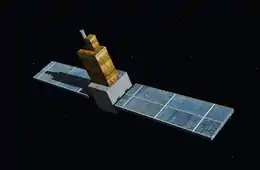Hisaki (satellite)
Hisaki, also known as the Spectroscopic Planet Observatory for Recognition of Interaction of Atmosphere (SPRINT-A) is a Japanese ultraviolet astronomy satellite operated by the Japan Aerospace Exploration Agency (JAXA). The first mission of the Small Scientific Satellite program,[2] it was launched in September 2013 on the maiden flight of the Epsilon rocket. It remains operational as of 2023 and is used for extreme ultraviolet observations of the Solar System planets.
 Artistic rendering of Hisaki in orbit. | |
| Mission type | Ultraviolet astronomy |
|---|---|
| Operator | JAXA |
| COSPAR ID | 2013-049A |
| SATCAT no. | 39253 |
| Website | www |
| Mission duration | ~1 year planned (science phase) elapsed: 10 years, 1 month and 11 days |
| Spacecraft properties | |
| Bus | NEXTAR NX-300L |
| Manufacturer | NEC |
| Launch mass | 348 kg (767 lb) |
| Dimensions | 4×1×1 m (13.1×3.3×3.3 ft) |
| Power | 900 watts |
| Start of mission | |
| Launch date | 14 September 2013, 05:00 UTC |
| Rocket | Epsilon |
| Launch site | Uchinoura |
| Orbital parameters | |
| Reference system | Geocentric |
| Regime | Low Earth |
| Semi-major axis | 7,431.52 kilometres (4,617.73 mi)[1] |
| Eccentricity | 0.0136807[1] |
| Perigee altitude | 957.9 kilometres (595.2 mi)[1] |
| Apogee altitude | 1,161.8 kilometres (721.9 mi)[1] |
| Inclination | 29.72 degrees[1] |
| Period | 106.27 minutes[1] |
| Epoch | 23 January 2015, 18:21:14 UTC[1] |
Launch and naming
Hisaki was launched with an Epsilon rocket, which was its first flight. The four-stage Epsilon rocket[3] flew from the Mu rocket launch complex at the Uchinoura Space Center. The launch occurred at 05:00 UTC on 14 September 2013, following a scrubbed launch attempt on 27 August 2013.[4] Following its successful insertion into orbit and deployment of its solar arrays, the satellite was renamed Hisaki, having been designated SPRINT-A until that point.[5]
Hisaki was named after a cape Hisaki (火崎, literally Cape Fire) used by local fishermen to pray for safe travels in the eastern part of Kimotsuki, Kagoshima near the Uchinoura Space Center, but has the additional meaning of "beyond the Sun".[6][7] An old name for the mission was EXCEED (Extreme Ultraviolet Spectroscope for Exospheric Dynamics).[8]
Observations
Hisaki carries an extreme ultraviolet spectrometer, which is used to study the composition of the atmospheres and the behavior of the magnetospheres of the planets of the Solar System.[9] Designed for a one-year mission, Hisaki has been operated in a low Earth orbit with a perigee of 950 km (590 mi), an apogee of 1,150 km (710 mi), 31 degrees of inclination and a period of 106 minutes.[10]
In October 2020 it performed joint observation with the BepiColombo probe which performed a flyby of Venus en route to Mercury.[11]
Hisaki remains operational as of June 2023, [12] and is performing joint observations with Juno orbiter.[13]
References
- "SPRINT-A (HISAKI) Satellite details 2013-049A NORAD 39253". N2YO. 23 January 2015. Retrieved 25 January 2015.
- "Shujiro Sawai, "Semi-Made-To-Order" Satellites: Faster, Cheaper, More Advanced". Japan Aerospace Exploration Agency. Archived from the original on 6 June 2013. Retrieved 27 August 2013.
- "Epsilon Launch Vehicle" (PDF). Japan Aerospace Exploration Agency. Archived from the original (PDF) on 21 September 2013. Retrieved 27 August 2013.
- Graham, William (26 August 2013). "Japan's Epsilon launch with SPRINT-A scrubbed". NASASpaceflight.com. Archived from the original on 30 August 2013. Retrieved 27 August 2013.
- Clark, Stephen (14 September 2013). "Japan's 'affordable' Epsilon rocket triumphs on first flight". Spaceflight Now. Retrieved 14 September 2013.
- "SPRINT-A: Solar Array Paddles Deployment and Nickname Decided". JAXA. 14 September 2013. Archived from the original on 15 September 2013. Retrieved 19 September 2013.
- イプシロン観測衛星、愛称は「ひさき」と命名. Yomiuri Online (in Japanese). Yomiuri Shimbun-sha. 14 September 2013. Retrieved 19 September 2013.
- F. Tsuchiya, et al. – Earth-orbiting Extreme Ultraviolet Spectroscopic Mission SPRINT-A/EXCEED
- Krebs, Gunter. "SPRINT A (EXCEED)". Gunter's Space Page. Retrieved 27 August 2013.
- "Spectroscopic Planet Observatory for Recognition of Integration of Atmosphere (SPRINT-A)". Japan Aerospace Exploration Agency. Archived from the original on 10 September 2013. Retrieved 27 August 2013.
- "BepiColombo flies by Venus en route to Mercury".
- Astronomical Observation Satellites In Operation. JAXA – Missions. Accessed 23 September 2015
- Response of Jupiter's inner magnetosphere to the solar wind derived from extreme ultraviolet monitoring of the Io plasma torus. Go Murakami, Kazuo Yoshioka, Atsushi Yamazaki, Fuminori Tsuchiya, Tomoki Kimura, Chihiro Tao, Hajime Kita, Masato Kagitani, Takeshi Sakanoi, Kazunori Uemizu, Yasumasa Kasaba, Ichiro Yoshikawa, Masaki Fujimoto. Geophysical Research Letters. 20 December 2016, doi: 10.1002/2016GL071675


